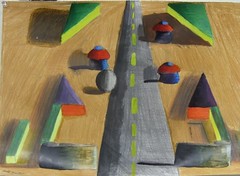Thursday, December 10, 2009
Lawrence of Arabia quiz 1; from Britain to Arabia
From Britain to Arabia
T 1. The greatest powers in World War II were the US and the Germans. World War I was very similar to WWII in regards the principal powers. T / F
A 2. Which group were the nomads of SW Asia? a) Bedouins b) Turks c) Christians
d) Arabs.
B 3. The Arabian Peninsula comprises a) 3 b) 6 c) 9 nations.
T 4. With Saudi Arabia's population about 28.6 million and Iraq's about 31.2 million, the two nations have similar demographics. T / F
D 5. The language that unites the devout men of the region of SW Asia: a) Islam
b) Hinduism c) Judaism d) Arabic.
F 6. Arabia is a peninsula because it is surrounded by water: the Red Sea, Persian Gulf, Mediterranean Sea and Arabian Sea. T / F
C 7. To get from Cairo to Mecca in 1914, you would connect with the Red Sea via the a) Gulf of Aden b) Gulf of Aqaba c) Gulf of Suez d) Persian Gulf.
D 8. The ancient name for the modern nation of Israel: a) Mesopotamia
b) Asia Minor c) Persia d) Palestine.
B 9. An ancient form of hieroglyphics called cuneiform writing is associated with today's a) Israel b) Iraq c) Iran d) Jordan.
A 10. The Mediterranean is connected to the Arabian Sea by the a) Suez Canal
b) Gulf of Aqaba c) Persian Gulf d) Nile R.
B 11. Name the island that lies at the southern end of the Italian peninsula and makes a virtual bridge between Europe and Africa. a) Malta b) Sicily c) Gibraltar
d) Sardinia.
C 12. The word "polyglot" means a person who a) knows history in depth b) is an archaeologist c) speaks several languages. On completing his degree in 1910, Lawrence commenced postgraduate research in medieval pottery at Magdalen College, Oxford, which he abandoned after he was offered the opportunity to become a practicing archaeologist in the Middle East. In December 1910 he sailed for Beirut, and on arrival went to Jbail (Byblos), where he studied Arabic. He was in fact a polyglot who could speak English, French, German, Latin, Greek, Arabic, Turkish and Syriac. He then went to work on the excavations at Carchemish, near Jerablus in northern Syria, where he worked under D. G. Hogarth and R. Campbell-Thompson of the British Museum. As the site lay close to the Turkish border, near an important crossing on the Baghdad Railway, knowledge gathered there was of considerable importance for military intelligence. While excavating ancient Mesopotamian sites, Lawrence met Gertrude Bell, who was to influence him during his time in the Middle East.

